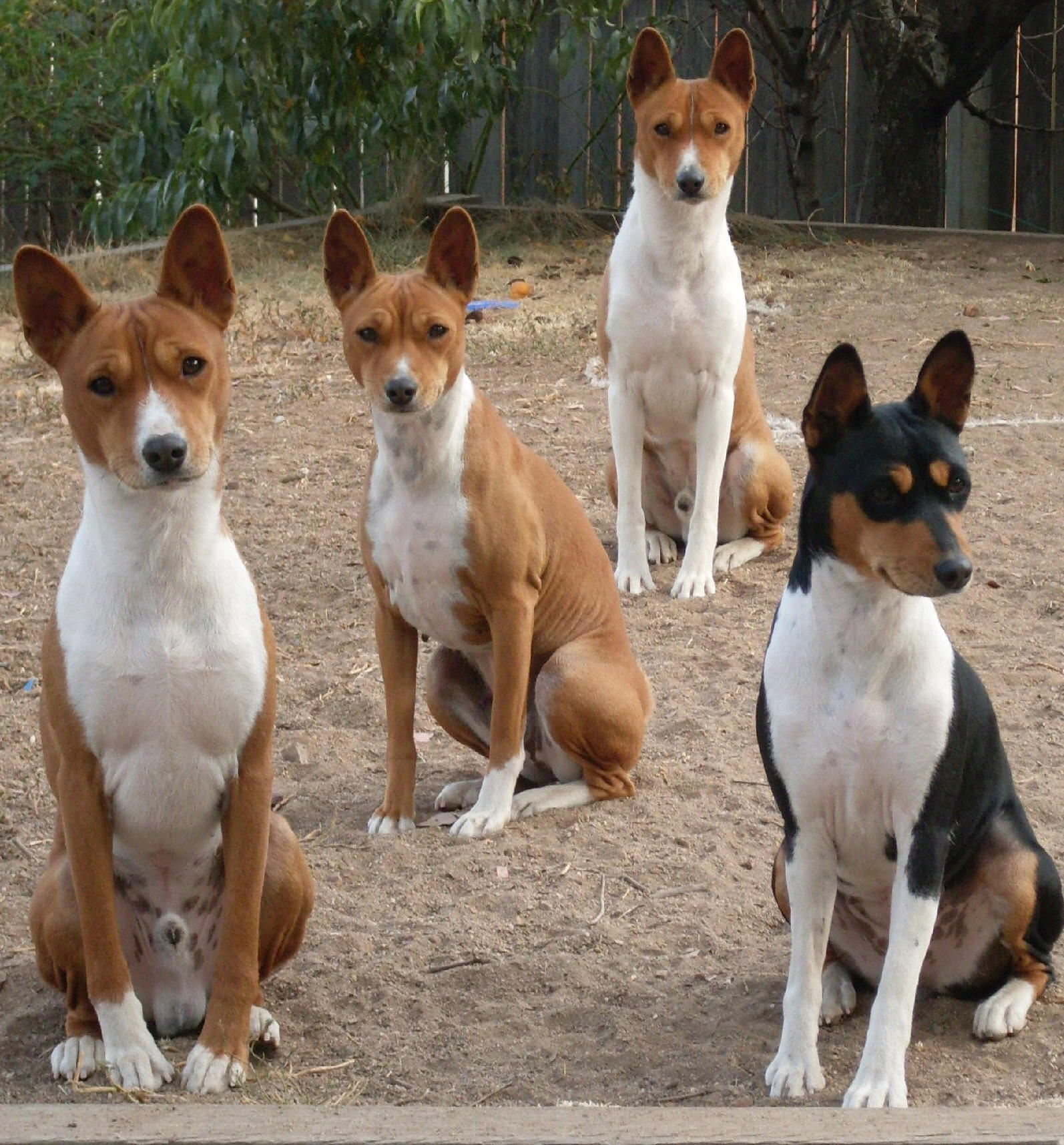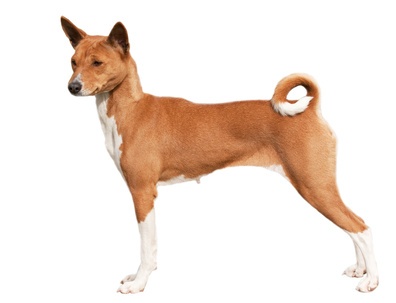
The Breed History
This breed originated in Central Africa, but gained popularity in
Egypt-they were given as prized gifts in the times of the Pharaohs.
They were exported to the US and Great Britain around 1937, and in
1943 they were first registered in the AKC. Basenjis are well known
for the absence of a true bark. They can make noise, but their varied
vocalizations are described as yodels, brrs, or roos. The name Basenji
probably originates from the African word for "Bush Thing". The
BCOA and other clubs worldwide are involved with the African Stock
Project to bring new Basenjis from Africa to expand the gene pool.
Breeding for Function
The breed was originally developed to point and retrieve, and for
hunting reed rats, an indigenous African variety that is particularly
large and vicious. They excel both as sight and scent dogs. They are
successful in agility competitions and are not now commonly used
for hunting.
Physical Characteristics
Height at Withers: female 16 " (40.5 cm), male 17" (43 cm).
Weight: females 22 lb (10 kg), males 24 (11 kg).
Coat: The short, glossy, smooth dense haircoat comes in black,
tri-color, brindle, chestnut red-all with white feet, chest and tip of
the tail. Distinct borders between colors are desired, and white should
never predominate though it can be present elsewhere. They are low
shedding dogs, with absent doggie odor and need minimal grooming.
Longevity: 10-12 years.
Points of Conformation: The tail is carried over the straight topline
in a curled position, head carriage is high, and the medium-sized
ears are carried pricked up, with a furrowed brow. Eyes are hazel to
brown. They have short backs, a definite waist and are well muscled
with strong bone. They have a horse-like smooth running trot.
Recognized Behavior Issues and Traits
Reported characteristics of these high activity dogs include: Playful,
smart, and are known to be courageous hunters. They tend to be
fastidious about staying clean, washing themselves with their
tongues like a cat. They are independently minded, and cautious
around strangers, while being calm and friendly with family,
including children. They like to be kept busy, and will do best with a
household that provides lots of playtime, exercise and attention.
They are considered a primitive evolved domestic dog.
Normal Physiologic Variations
Females go into heat once a year.
Basenjis have lower resting T4 thyroid levels, similar to sight hounds.
Check thyroid status with thyroid profiles.
Pelger-Huet Anomaly: Basenjis have been diagnosed with this
autosomal recessive blood anomaly. Causes neutrophils with round,
oval, or bean-shaped nuclei and only rare segmented nuclei. No
obvious liability to disease seen in affected dogs.
Drug Sensitivities
None reported
Inherited Diseases
Fanconi Syndrome: Inherited defect in renal tubular transport. Causes
glucosuria, hyposthenuria, metabolic acidosis, hyperchloremia, and
reduction in glomerular filtration rate. Onset 3-11 years of age. Diagnose
by finding glucosuria with normal blood glucose levels. Treat with
medications and diet. Seen worldwide. Dorn reports an 11.48x odds ratio
in Basenjis versus other breeds. Prevalence of 10% in the United States
Basenji population. A linked marker test is offered by the OFA, which
suggests an autosomal recessive mode of inheritance. Genetic testing
shows 6.3% affected and 41.2% carrier.
Hip Dysplasia: Polygenically inherited trait causing degenerative
joint disease and hip arthritis. OFA reports 3.2% affected.
Patella Luxation: Polygenically inherited laxity of patellar ligaments,
causing luxation, lameness, and later degenerative joint disease.
Treat surgically if causing clinical signs. OFA reports 1.5% affected.
Elbow Dysplasia: Polygenically inherited trait causing elbow
arthritis. OFA reports 2.4% affected.
Pyruvate Kinase Deficiency (PK, Basenji Hemolytic Anemia):
Autosomal recessive disorder causing severe hemolytic anemia,
progressive osteomyelosclerosis, and hemosiderosis. Death occurs
due to anemia or hepatic failure usually at less than five years of age.
Occurs at a low frequency in the breed. A genetic test is available.
Disease Predispositions
Persistent Pupillary Membranes: Strands of fetal remnant
connecting; iris to iris, cornea, lens, or involving sheets of tissue. The
later three forms can impair vision, and dogs affected with these
forms should not be bred. PPMs can be associated with corneal
opacity or coloboma in this breed. Dorn reports a 110.61x odds ratio
in Basenjis versus other breeds. Identified in 47.64% of Basenjis
CERF examined by veterinary ophthalmologists between 2000-2005.
Of these, 9.47% were iris to cornea, 3.71% were iris to lens, and
0.47% were iris sheets. PPMs are shown to be inherited in this
breed, but the mode of inheritance has not been determined.
Hypothyroidism: Inherited autoimmune thyroiditis. 10.8% positive
for thyroid auto-antibodies based on testing at Michigan State
University. (Ave. for all breeds is 7.5%).
Corneal Dystrophy: The endothelial form is associated with
persistant papillary membranes in this breed, and can cause edema,
keratits, and loss of vision. Basenjis with the endothelial form
should not be bred. The epithelial-stromal form causes opacities
on the surface of the cornea. Unknown mode of inheritance. The
endothelial form is identified in 2.70%, and the epithelial-stromal
form is identified in 2.23% of Basenjis CERF examined by veterinary
ophthalmologists between 2000-2005.
Cataracts: Posterior and capsular punctate cataracts predominate
in the breed. Identified in 2.41% of Basenjis CERF examined by
veterinary ophthalmologists between 2000-2005. CERF does not
recommend breeding any Basenji with cataracts.
Progressive Retinal Atrophy (PRA): Progressive degeneration
of the retina, eventually causing blindness. Typical age of onset
between 4 to 10 years, with some reported between ages 3 and
13. Presumed autosomal recessive inheritance. CERF recommends
that any Basenji with PRA should not be bred. 1.62% of Basenjis
CERF examined by veterinary ophthalmologists between 2000-2005
are labeled suspicious for PRA, and 0.65% are identified with
generalized PRA. No genetic test is available.
Demodicosis: Dorn reports a 2.07x odds ratio of developing
demodectic mange versus other breeds. This disorder has an
underlying immunodeficiency in its pathogenesis.
Optic Nerve Coloboma: Congenital cavity in the optic nerve that
can cause blindness or vision impairment. Affected dogs should
not be bred. Identified in 0.79% of Basenjis CERF examined by
veterinary ophthalmologists between 2000-2005. Can be associated
with persistent pupillary membranes in this breed.
Immunoproliferative Enteropathy (IPEB, IPSID,
Lymphangiectasia): Inherited disorder causing chronic diarrhea,
progressive emaciation, malabsorption and maldigestion. Biopsy
findings include villous clubbing and fusion, increased tortuosity of
intestinal crypts, and diffuse infiltration of mononuclear inflammatory
cells. Lymphangectasia may be secondary. Treatment with
immunosuppressive drugs and diet. Unknown mode of inheritance.
Cystine Urinary Calculi: Seen at an increased frequency in the
breed secondary to cystinuria from Fanconi syndrome.
Epilepsy, Retinal Dysplasia and Umbilical Hernia are reported.
Isolated Case Studies
Intrahepatic Venous Obstruction: Intrahepatic post-sinusoidal
obstruction, similar to congenital Budd-Chiari syndrome in human
patients, was diagnosed in a young Basenji dog.
Genetic Tests
Tests of Genotype: Phenotypic test for Fanconi Syndrome is
available from PennGen.
Linked marker test for Fanconi Syndrome is available from the OFA.
Direct test for pyruvate kinase deficiency is available from
HealthGene, Optigen, PennGen, University of Missouri, and VetGen.
Direct tests for color alleles is available from VetGen.
Tests of Phenotype: CHIC Certification: Required testing includes
hip radiographs, thyroid profile including autoantibodies, CERF eye
examination (each year until 6, thereafter every 2 years), and linked
marker test for Fanconi syndrome from OFA. (See CHIC website;
caninehealthinfo.org).
Recommend patella evaluation, elbow radiographs, and cardiac
evaluation.
Miscellaneous
- Breed name synonyms: Barkless dog, Congo dog, Congo Terrier
- Registries: AKC, CKC, UKC (provisional), KCGB (Kennel Club
of Great Britain), ANKC (Australian National Kennel Club), NKC
(National Kennel Club)
- AKC rank (year 2008): 85 (774 dogs registered)
- Internet resources: The Basenji Club of America:
basenji.org
Basenji Club of Canada: basenjiclubofcanada.com
The Basenji Club of Great Britain: basenjiclubofgb.org
The Basenji Health Endowment: basenjihealth.org
Photo Gallery of Breed - Basenji - Dog Breed








 Animalia Life
Animalia Life